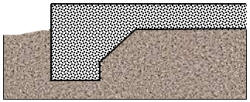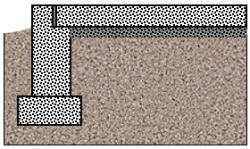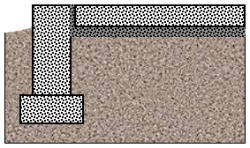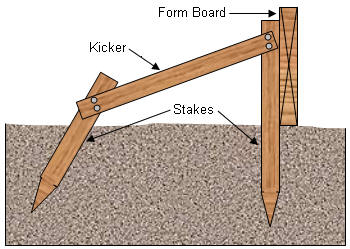- One integral unit, as shown in Figure 7.

Figure 7 - Slab on grade with integral foundation
- Supported by a foundation wall, as shown in Figure 8,

Figure 8 - Slab on grade with supporting foundation wall
- Independent slab and foundation wall, as shown in Figure 9,

Figure 9 - Slab on grade with independent foundation
The following procedure details the construction methodology for a slab on grade foundation:
- Site Clearance:
- Lay Out Foundation:
- Install The Form Boards:
As a general rule, there is little if any excavation required to pour a slab on grade foundation. Brush and trees are removed by a small bulldozer and to spread any fill that may be necessary for leveling.
As a general rule, there is little if any excavation required to pour a slab on grade foundation. Brush and trees are removed by a small bulldozer and to spread any fill that may be necessary for leveling.
Install batter boards and strings to define the outline of the foundation. The batter boards that are tied to the stakes should be no less than 8″ above final grade.

Figure 10 - Proper bracing for a concrete form
The forms that are used to pour the concrete are generally 2 X material and are aligned with the strings. Some contractors will use metal forms, especially if they are constructing a number of duplicate foundations.
The forms must be held in place securely as there is a tremendous amount of weight in wet concrete. This is an area where many home handymen skimp, with the result that the forms bend or, even worse, break open before the concrete has cured.
The proper method to secure the concrete form is to place a 2 X 4 stake adjacent to the form board. Another 2 X 4 stake is driven at an angle approximately 3' from the form board. A board called a kicker is then used to tie the two 2 X 4 stakes together, as shown in Figure 10. The braces should be placed a minimum of every 4' around the perimeter of the form.
Before pouring the concrete, test the form. If you can bend it or move the form, at all, by pushing or pulling on it, you must add additional bracing.
